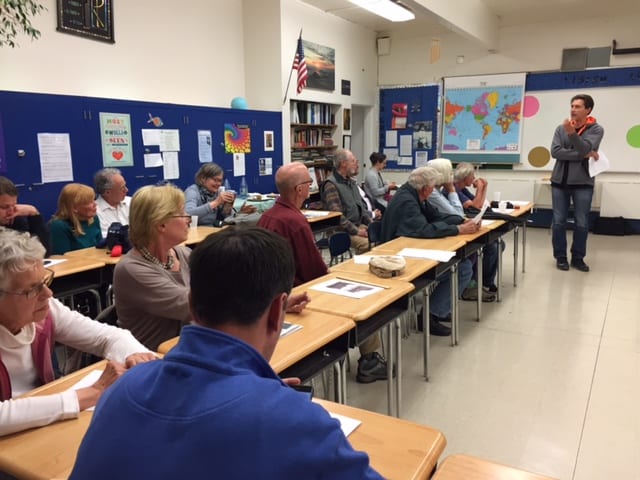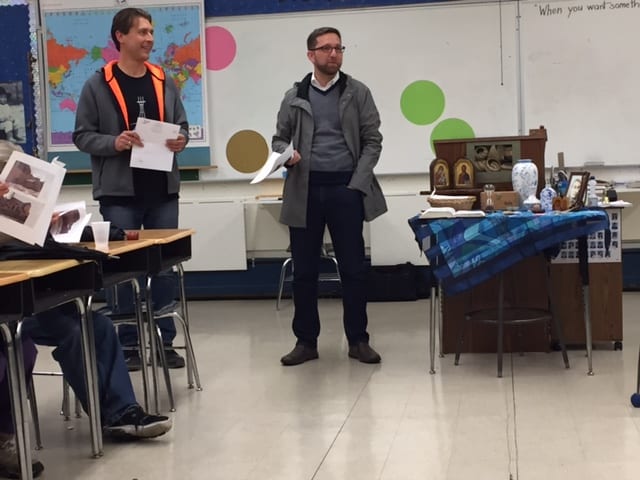Photos by Bonnee Waldstein
The quarterly meeting of the Glen Park Association, on April 6 at St. John School, focused on updating the community on two major ongoing projects, as well as a presentation on the proposed rate increase by Recology — plus a surprise ending.

New Glen Park Association President Scott Stawicki presiding
GREENWAY PROJECT:
Nicholas Dewar is doing much of the behind-the-scenes groundwork for the project and gave an update on current activities.
The Greenway aims to connect the green space along Bosworth Street, from Brompton to Burnside Avenues, to Glen Canyon Park through a series of differing natural features. The final connection from Burnside to Elk Street is yet to be determined. The details, while not final, were presented in preliminary plans and discussed and debated at prior meetings. Funding for this planning stage, which resulted in an overall concept plan, came from various grants totaling $60,000.
“The big work is now focused on fundraising for the next phase,” said Dewar. “In the last month, we have submitted five applications aimed at tree planting, irrigation systems to get them started, demonstration plantings, and signage to explain what we’re doing.” If funding comes through in the next three to four months, there will be a planning meeting for community input in September.
One person asked about the rough patch of rocks and roots between Chilton and Burnside, and the accumulation of water in this area. Dewar said that the concept plan included laying a proper path for strollers, etc. but it won’t happen right away.
Another commented on how many trees are dead between Brompton and Burnside. According to the landscape architect on the project, there’s room for twenty full grown trees. However, it’s better to start with saplings because they will adapt more quickly. The tree of choice is the coast live oak. DPW is in favor of it as well because they produce a rich forest ecosystem, are drought tolerant and climate friendly.
One of the attendees, Jim Billings, who is active in San Francisco Beautiful, suggested that this organization could possibly help with tasks through their “Done in a Day” program.
The community will take part in quarterly work parties for three hours on Saturdays. They’re fun and productive. DPW supports the effort by sending in their Green Team to help out, and their big truck to haul stuff away. The next work day will be sometime in July. At the November or December work day, Friends of the Urban Forest (FUF) will play a major role in clearing and tree planting.
To keep up with the Greenway Project, go to www.glenparkassociation.org and click on “Greenway.”
GLEN CANYON PARK RECREATION CENTER:
Opening day: June 5, 2017
Final plans for the reopening of the renovated Rec Center were detailed by Brett Desmarais, Project Manager for S.F. Recreation and Park Department. The over $14 million in funding for the renovation came from the 2012 Clean and Safe Neighborhoods Parks Bond. (A small amount of that came from the 2008 bond.)

Brett Desmarais of Rec & Park
The project is almost complete. “I can’t wait for people to come in and see the interior. It’s really stunning,” said Desmarais. Monday morning, June 5, will be the first day of rock climbing camp. It will run through August 11 for ages 6-12.
Most of the work has been exterior until now: a new roof, operable windows, stucco siding with anti-graffiti coating extending up ten feet, outdoor patio, and landscape spaces.
The interior was taken down to the studs. Major systems have been put in place, including seismic, electric and fire alarm upgrades. Security will be improved with cameras, motion sensors and keypad access to some areas. A state of the art automatic climate control system is also gold level LEED (Leadership in Energy and Environmental Design) compliant.
There are many recreational and program enhancements. The gym has been renovated and has six retractable basketball hoops. There are a scoreboard, bleachers, and three multipurpose rooms, plus a building extension.
Two new exterior bathrooms close to the playground, and two interior bathrooms will provide much needed convenience.
The new Rec Center will feature after school programs, drop-in basketball, yoga and other classes, and private events. Five on-site staff will oversee activities both inside and outside on weekdays, and weekends depending on the program. Interior classrooms can be rented through the program office.
There was a question about the picnic tables. They will be replaced in another area, as the original location will be redone with solar totems in a three-part art installation. One resident complained that the picnic tables were funded by the community but were being rented out and thus unavailable for community use. This issue will be followed up.
Other issues raised and discussed were to screen in the garbage cans (they will be), repair rusting fences and restore lost field lighting (to be followed up).
Glen Park Association President Scott Stawicki invited Desmarais back in the next quarter to give a follow up on the many questions that were raised.
For updates, go to www.sfrecpark.org/project/glen-canyon-park-2012-bond/
RECOLOGY RATE INCREASE:
The Refuse Rate Increase Proposal was presented by Rosie Dilger, a rate payer advocate. She is contracted by DPW to explain the proposal and gather feedback from the San Francisco communities. Rate payers may also submit written suggestions, opposition, and comments.
The proposed rate structure is designed to support the zero waste goals set by the City with new programs; improve the infrastructure of the recycling and composting facilities; enhance collection services such as new recycling bins; establish new outreach and education programs; and institute new reporting requirements to the State. In addition, the proposal includes a new five-year labor union agreement.
The final decision will be made by the City Controller and the Director of the PUC. If approved, the new rates will take effect on July 1, 2017.
The rate increase is a tiered program that would take effect over 4 years. For a single family home, in the first year there would be an effective increase of 16.4%, or about $5.70 per month. The second year would see a 4.98% increase, none in the third year, and 0.62% in the fourth year. Several residents voiced opposition to the new rates. For example, “It’s so expensive to get to zero waste so let’s raise rates on the citizens of San Francisco.” There were also complaints about the complexity of the rate structure.
Someone commented about extensive postings on Nextdoor in which people were confused about cardboard (the “Amazon effect”); blue bin or green; inside or outside the pail, etc. They suggested a more detailed website as part of the education program.
Concern was expressed about how low income people and seniors can absorb the additional expense. Dilger said that was the most frequent complaint she’s heard in the dozens of community meetings she’s done. She noted that there is a Lifeline Program which provides a 25% discount for those who qualify.
Dilger assured a skeptical questioner that, indeed, community outreach in the matter of rates has led to a different result. In fact it did, on the last rate increase.
For details of the proposal, go to www.ratepayeradvocatesf.org
SURPRISE: BEES?!
Andrea (no last name given), who lives on the border of Glen Park and Sunnyside, spoke to the meeting about the proliferation of beekeeping in the neighborhood. She said there are many beekeepers in her neighborhood and each man-made hive can have up to 100,000 bees. Last year they had up to 700,000 flying over their homes and in their yards.
What could possibly go wrong?
For one thing, and Andrea tried to be delicate about this, bees poop — a lot. It looks like little yellow dots and lands, well, everywhere, like cars, clothes, hair and homes.
For another, bees do not respect property boundaries and go into neighboring yards where they might not be so welcome, especially if a neighbor has a bee allergy. Or maybe they just don’t like bees. In any case, it impacts the use of their own yard.
Bee hobbyists get hives in April, all excited. At the end of April into May, the bees will swarm. They can get into houses through cracks. A “bee person” has to be paid to open the wall, fix the problem, and close the wall back up.
Neighborliness and empathy can be powerful tools in a tight-knit neighborhood such as ours. San Francisco currently has no regulations on beekeeping. Andrea’s group made a website to inform people about the impact of bringing bees into a densely populated residential neighborood, and maybe get some help from the City.
To learn more, go to www.urbanbeeimpact.com.